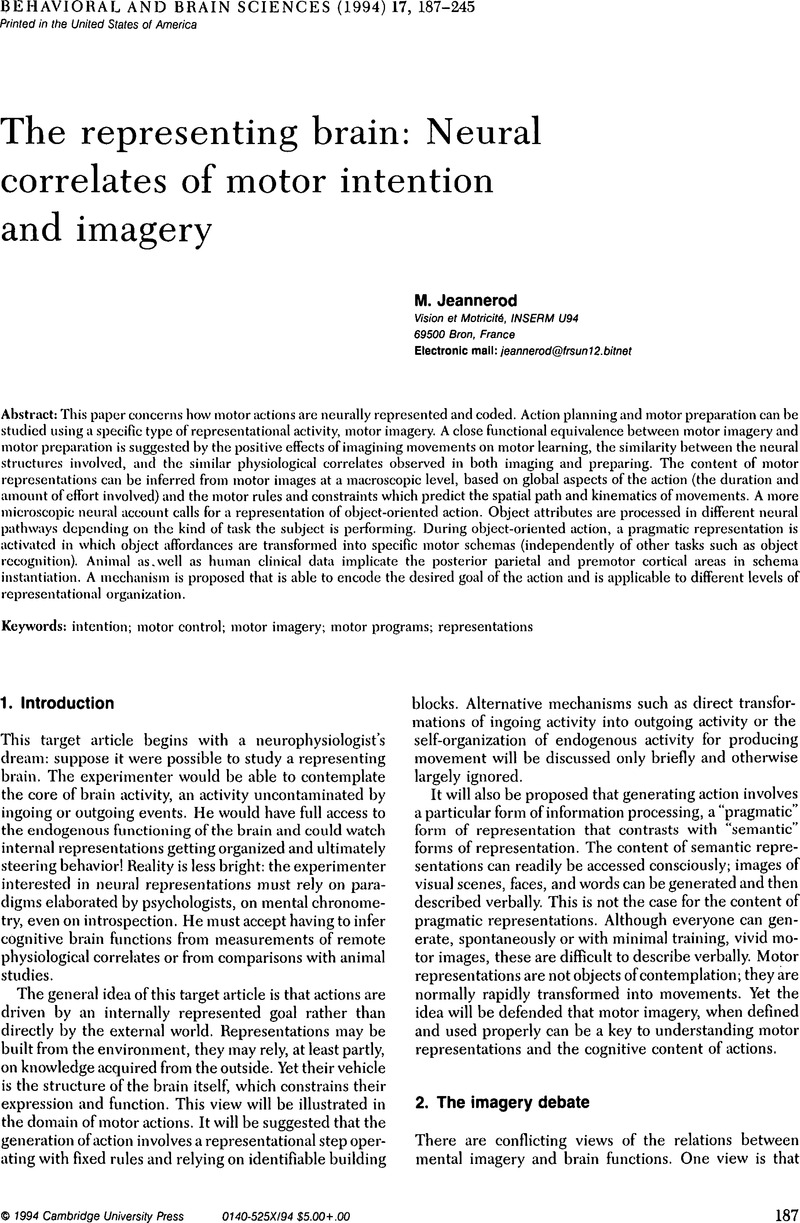Crossref Citations
This article has been cited by the following publications. This list is generated based on data provided by Crossref.
Hatsopoulos, Nicholas G.
and
Warren, William H.
1995.
Do control variables exist?.
Behavioral and Brain Sciences,
Vol. 18,
Issue. 4,
p.
762.
Thelen, Esther
1995.
Origins of origins of motor control.
Behavioral and Brain Sciences,
Vol. 18,
Issue. 4,
p.
780.
Windhorst, U.
1995.
Levers to generate movement.
Behavioral and Brain Sciences,
Vol. 18,
Issue. 4,
p.
784.
Haggard, Patrick
Miall, Chris
and
Stein, John
1995.
Twisted pairs: Does the motor system really care about joint configurations?.
Behavioral and Brain Sciences,
Vol. 18,
Issue. 4,
p.
758.
Latash, Mark L.
1995.
Equilibrium-point control? Yes! Deterministic mechanisms of control? No!.
Behavioral and Brain Sciences,
Vol. 18,
Issue. 4,
p.
765.
Wright, Charles E.
and
States, Rebecca A.
1995.
Biological variability and control of movements via δλ.
Behavioral and Brain Sciences,
Vol. 18,
Issue. 4,
p.
786.
McDonald, P. Vernon
1995.
Can the λ model benefit from understanding human adaptation in weightlessness(and vice versa)?.
Behavioral and Brain Sciences,
Vol. 18,
Issue. 4,
p.
768.
Giszter, Simon
1995.
The case of the missing CVs: Multi-joint primitives.
Behavioral and Brain Sciences,
Vol. 18,
Issue. 4,
p.
755.
Flanagan, J. Randall
Tresilian, James R.
and
Wing, Alan M.
1995.
Grip force adjustments during rapid hand movements suggest that detailed movement kinematics are predicted.
Behavioral and Brain Sciences,
Vol. 18,
Issue. 4,
p.
753.
Ostry, David J.
Laboissière, Rafael
and
Gribble, Paul L.
1995.
Command invariants and the frame of reference for human movement.
Behavioral and Brain Sciences,
Vol. 18,
Issue. 4,
p.
770.
Pribram, Karl H.
1995.
Position is everything?.
Behavioral and Brain Sciences,
Vol. 18,
Issue. 4,
p.
776.
Partridge, Lloyd D.
1995.
Let us accept a “controlled trade-off” model of motor control.
Behavioral and Brain Sciences,
Vol. 18,
Issue. 4,
p.
773.
Fikes, Thomas G.
and
Townsend, James T.
1995.
Moving models of motion forward: Explication and a new concept.
Behavioral and Brain Sciences,
Vol. 18,
Issue. 4,
p.
751.
Goodman, Simon R.
1995.
Inverse kinematic problem: Solutions by pseudoinversion, inversion and no-inversion.
Behavioral and Brain Sciences,
Vol. 18,
Issue. 4,
p.
756.
Desmurget, Michel
Rossetti, Yves
and
Prablanc, Claude
1995.
Natural unconstrained movements obey rules different from constrained elementary movements.
Behavioral and Brain Sciences,
Vol. 18,
Issue. 4,
p.
750.
Lestienne, F.
Ghafouri, M.
and
Thullier, F.
1995.
What does body configuration in microgravity tell us about the contribution of intra- and extrapersonal frames of reference for motor control?.
Behavioral and Brain Sciences,
Vol. 18,
Issue. 4,
p.
766.
Corcos, Daniel M.
and
Pfann, Kerstin
1995.
Conservative or nonconservative control schemes.
Behavioral and Brain Sciences,
Vol. 18,
Issue. 4,
p.
747.
Sternad, Dagmar
and
Turvey, M. T.
1995.
Control parameters, equilibria, and coordination dynamics.
Behavioral and Brain Sciences,
Vol. 18,
Issue. 4,
p.
780.
Alexander, R. McN.
1995.
Tendon elasticity and positional control.
Behavioral and Brain Sciences,
Vol. 18,
Issue. 4,
p.
745.
Loeb, Gerald E.
1995.
What can we expect from models of motor control?.
Behavioral and Brain Sciences,
Vol. 18,
Issue. 4,
p.
767.



